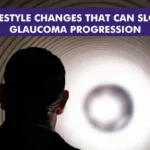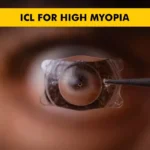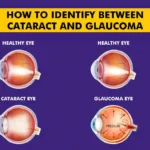Cataracts are a significant cause of vision impairment worldwide, particularly in aging individuals. They develop when the proteins in the eye’s natural lens break down and clump together, leading to clouding of vision. Cataracts progress gradually and can interfere with daily activities, including reading, driving, and recognizing faces. Understanding the risk factors of cataract is essential for early prevention and management. While aging is the most significant cause, various other medical and lifestyle factors contribute to cataract development. This blog provides a comprehensive look at these risk factors and discusses the concerns associated with cataract surgery.
What Is a Cataract?
A cataract is the clouding of the eye’s lens, which leads to reduced vision clarity, increased glare sensitivity, and difficulty seeing at night. The condition develops due to changes in the protein structure of the lens, which causes it to become opaque over time. If left untreated, cataracts can lead to severe visual impairment and even blindness.
Common Risk Factors of Cataract
Several risk factors contribute to cataract formation. Some of these are unavoidable, such as aging and genetics, while others, like smoking and UV exposure, can be controlled through lifestyle choices. Below are the key factors that increase the likelihood of developing cataracts.
Age and Cataract Formation
Aging is the most common cause of cataract formation. As individuals grow older, the natural proteins in the eye’s lens undergo chemical changes that cause them to clump together, leading to cloudiness. By the age of 65, more than half of the population will develop some degree of cataract. The risk continues to rise with advancing age, and cataracts may develop in both eyes over time.
Genetic Predisposition
Heredity plays a role in cataract development. If close family members have had cataracts, the condition will likely develop earlier in life. Genetic factors influence how the eye’s lens ages and its susceptibility to damage.
Prolonged UV Exposure
Excessive exposure to ultraviolet (UV) radiation from sunlight can accelerate lens deterioration and lead to the early onset of cataracts. The harmful UV rays cause oxidative damage to the proteins in the lens, promoting cloudiness. Wearing sunglasses with 100% UV protection and using wide-brimmed hats can help mitigate this risk.
Smoking and Alcohol Consumption
Smoking has been strongly linked to an increased risk of cataracts. The toxic chemicals in cigarette smoke cause oxidative stress in the eye’s lens, leading to protein damage and lens clouding. Studies show that smokers are twice as likely to develop cataracts compared to non-smokers. Similarly, excessive alcohol consumption may contribute to the early formation of cataracts by depleting essential antioxidants that protect the eyes.
Diabetes and Other Health Conditions
Individuals with diabetes are at a significantly higher risk of developing cataracts. Elevated blood sugar levels lead to sorbitol accumulation in the lens, which causes swelling and opacity. Other medical conditions, such as hypertension and obesity, also contribute to cataract formation by promoting systemic inflammation and oxidative damage.
Eye Injuries and Trauma
Previous eye injuries, such as blunt trauma, chemical burns, or surgery, can lead to traumatic cataracts. Damage to the lens can cause it to become cloudy immediately or lead to cataract formation over time. Individuals working in environments with high injury risk should wear protective eyewear.
Prolonged Use of Corticosteroids
Long-term use of corticosteroid medications, particularly in high doses, has been associated with an increased risk of cataract formation. Steroids alter the biochemical environment of the lens, leading to changes in its transparency. Patients on long-term steroid therapy should undergo regular eye examinations.
Dietary and Nutritional Deficiencies
A poor diet lacking essential nutrients such as vitamins C and E, lutein, and zeaxanthin can accelerate cataract development. Antioxidants play a crucial role in protecting the lens from oxidative stress. Consuming a diet rich in green leafy vegetables, citrus fruits, and nuts can help reduce the risk.
Complications of Cataract Surgery with Glaucoma
Patients with cataracts and glaucoma face unique challenges during and after surgery. Since glaucoma affects intraocular pressure (IOP), any surgical intervention can lead to fluctuations in pressure, which may worsen the condition. Patients with advanced glaucoma may experience delayed healing or require additional treatments after surgery. Additionally, individuals with glaucoma may need modifications in surgical techniques to ensure minimal disruption to eye pressure. Close monitoring and follow-up appointments are essential to prevent further optic nerve damage.
Learn about the various Reasons For Cataracts.
Preventing Cataract Development
While not all cataracts can be prevented, lifestyle changes and regular eye care can slow their progression. Avoiding excessive UV exposure by wearing protective sunglasses, maintaining a healthy diet rich in antioxidants, quitting smoking, and limiting alcohol consumption can help reduce the risk. Managing underlying conditions like diabetes and hypertension through proper medical care also plays a crucial role in delaying cataract onset. Additionally, regular eye check-ups allow early detection and management before cataracts interfere with daily life.
Conclusion
Understanding the risk factors of cataract enables individuals to take proactive steps in preserving vision. Regular eye check-ups, healthy lifestyle choices, and prompt medical intervention contribute to long-term eye health.
Take control of your eye health today. Schedule a comprehensive eye examination to detect cataracts early. Book an Eye Check-Up Now!
FAQs
While cataract surgery restores vision, potential drawbacks include the need for reading glasses post-surgery and rare complications such as corneal swelling.
Cataract surgery is usually painless due to local anesthesia. Some patients may feel mild pressure, but discomfort is minimal.
Posterior capsule opacification (PCO) is the most common complication, causing vision to become cloudy after surgery. It is treatable with a quick laser procedure.
While cataracts are not life-threatening, untreated cases can lead to blindness. Early diagnosis and timely surgery help maintain vision.
Potential side effects include temporary inflammation, dry eyes, and light sensitivity. Serious complications are rare but require prompt medical attention.





